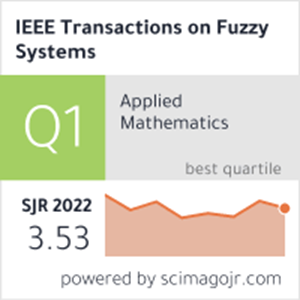Observer-Based SMC for Discrete Interval Type-2 Fuzzy Semi-Markov Jump Models
IF 10.7
1区 计算机科学
Q1 COMPUTER SCIENCE, ARTIFICIAL INTELLIGENCE
引用次数: 0
Abstract
This study is devoted to the observer-based sliding mode control (SMC) for discrete nonlinear semi-Markov jump models with incomplete sojourn information and application to the quarter-car suspension model. The nonlinear plant with parameter uncertainty is represented by an interval type-2 fuzzy model, where the membership functions of the fuzzy rules are related to the system mode. Since sojourn information is challenging to obtain in practice, the sojourn time probability density function is considered to be incompletely available. The considered system is more general, not only relaxing the traditional assumption that all the sojourn time probability density functions are completely available, but also covering completely available sojourn time probability density functions as a special case. The main innovation is that an observer-based SMC scheme is designed, which makes the discrete nonlinear models have better dynamic performance, and realizes the reachability of discrete quasi-sliding mode. By the interval type-2 fuzzy and classical Lyapunov function, the mean-square stability criterion of the semi-Markov jump models is constructed employing additional matrix variables. Then, an observer-based SMC mechanism is constructed to achieve the reachability of the quasi-sliding mode. Ultimately, the proposed method is validated by a two-degree-freedom quarter-car suspension model.基于观测器的离散区间2型模糊半马尔可夫跳变模型SMC
研究了具有不完全逗留信息的离散非线性半马尔可夫跳跃模型的基于观测器的滑模控制,并将其应用于四分之一汽车悬架模型。将具有参数不确定性的非线性对象用区间2型模糊模型表示,其中模糊规则的隶属度函数与系统模式相关。由于驻留信息在实际操作中难以获得,因此认为驻留时间概率密度函数是不完全可用的。所考虑的系统具有较强的通用性,不仅打破了传统的所有停留时间概率密度函数都是完全可用的假设,而且将停留时间概率密度函数作为一种特例进行了覆盖。主要创新点在于设计了基于观测器的SMC方案,使离散非线性模型具有更好的动态性能,实现了离散准滑模的可达性。利用区间2型模糊经典Lyapunov函数,利用附加矩阵变量构造了半马尔可夫跳变模型的均方稳定性判据。然后,构造了一种基于观测器的SMC机制来实现准滑模的可达性。最后,通过一个二自由度四分之一汽车悬架模型对所提方法进行了验证。
本文章由计算机程序翻译,如有差异,请以英文原文为准。
求助全文
约1分钟内获得全文
求助全文
来源期刊

IEEE Transactions on Fuzzy Systems
工程技术-工程:电子与电气
CiteScore
20.50
自引率
13.40%
发文量
517
审稿时长
3.0 months
期刊介绍:
The IEEE Transactions on Fuzzy Systems is a scholarly journal that focuses on the theory, design, and application of fuzzy systems. It aims to publish high-quality technical papers that contribute significant technical knowledge and exploratory developments in the field of fuzzy systems. The journal particularly emphasizes engineering systems and scientific applications. In addition to research articles, the Transactions also includes a letters section featuring current information, comments, and rebuttals related to published papers.
 求助内容:
求助内容: 应助结果提醒方式:
应助结果提醒方式:


